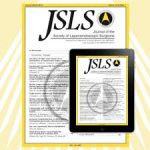Chang CG, Thackeray L
JSLS 2016 Jan-Mar;20(1).
BACKGROUND AND OBJECTIVES:
Hiatal hernia is a common condition often associated with symptomatic gastroesophageal reflux disease (GERD). The objectives of this study were to examine the efficacy and safety of laparoscopic hiatal hernia repair (LHHR) with biologic mesh to reduce and/or alleviate GERD symptoms and associated hiatal hernia recurrence.
METHODS:
We retrospectively reviewed consecutive LHHR procedures with biologic mesh performed by a single surgeon from July 2009 to October 2014. The primary efficacy outcome measures were relief from GERD symptoms, as measured according to the GERD-health-related quality-of-life (GERD-HRQL) scale and hiatal hernia recurrence. A secondary outcome measure was overall safety of the procedure.
RESULTS:
A total of 221 patients underwent LHHR with biologic mesh during the study period, and pre- and postoperative GERD-HRQL studies were available for 172 of them. At baseline (preoperative), the mean GERD-HRQL score for all procedures was 18.5 ± 14.4. At follow-up (mean, 14.5 ± 11.0 months [range, 2.0-56.0]), the score showed a statistically significant decline to a mean of 4.4 ± 7.5 (P < .0001). To date, 8 patients (3.6%, 8/221) have had a documented anatomic hiatal hernia recurrence. However, a secondary hiatal hernia repair reoperation was necessary in only 1 patient. Most complications were minor (dysphagia, nausea and vomiting). However, there was 1 death caused by a hemorrhage that occurred 1 week after surgery.
CONCLUSIONS:
Laparoscopic hiatal hernia repair using biologic mesh, both with and without a simultaneous bariatric or antireflux procedure, is an efficacious and safe therapeutic option for management of hiatal hernia, prevention of recurrence, and relief of symptomatic GERD.
Link to open access PDF: Chang CG, Thackeray L; JSLS. 2016 Jan-Mar;20(1).


